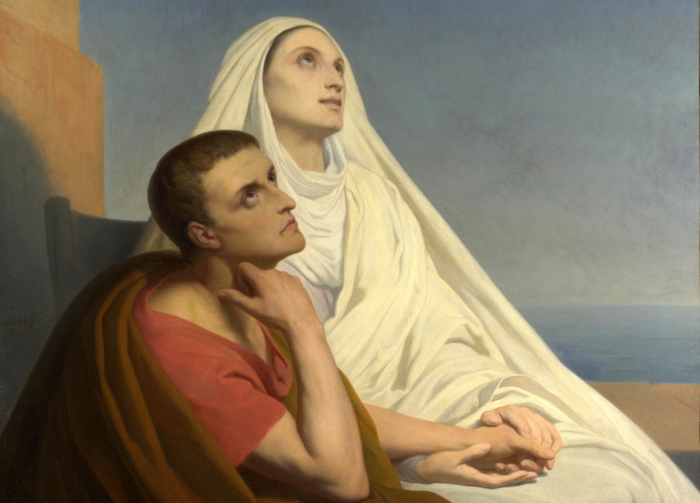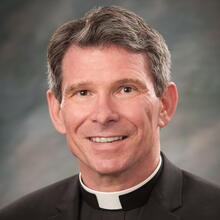St. Augustine took his mother Monica for granted for most of her life. He certainly underestimated her intelligence. As a young scholar, he thought that her Catholic faith was fine for simpletons but not for him. After he embraced that very faith, he records being surprised by his mother’s intelligence as she spoke in a small study group of intellectuals, which her son had organized.
But don’t be too hard on Augustine. In his day, the idea of any woman joining such a discussion was unthinkable—at least to men.
When we gather for Eucharist, we gather with Christ and with all of his saints.
Yet by the time of her death, Augustine had come to realize what he had in his mother: a source of unconditional love, a powerful intellect and a channel of mystical grace. Although written in the late fourth century, his account of her death reads as quite contemporary, especially the discussion of burial details:
One day during her illness she lapsed into unconsciousness and for a short time was unaware of her surroundings. We all came running, but she quickly returned to her senses, and, gazing at me and my brother as we stood there, she asked in puzzlement, “Where was I?” We were bewildered with grief, but she looked keenly at us and said, “You are to bury your mother here.” I was silent, holding back my tears but my brother said something about his hope that she would not die far from home, but in her own country, for that would be a happier way. On hearing this she looked anxious and her eyes rebuked him for thinking so; then she turned her gaze from him to me and said, “What silly talk!” Not long afterward, addressing us both, she said, “Lay this body anywhere, and take no trouble over it. One thing only do I ask of you, that you remember me at the altar of the Lord wherever you may be.” Having made her meaning clear to us with such words as she could muster, she fell silent, and travailed as the disease grew worse (IX.11).
What did Monica mean by asking that she be remembered by her sons “at the altar of the Lord, wherever you may be?”
Certainly, she was referring to the Eucharist, which does not vary in meaning or significance from one church to another. Praying for the dead is in evidence at every stage of the church’s development, so Monica was clearly asking that prayers be offered on her behalf at the celebration of the Eucharist. There is also a second reading: Monica was also directing her sons to look for her in the Eucharist, telling them that they would know a deeper communion with her within it than by any visit to a grave site.
We cannot see the saints gathered around the altar of the Lord, but we trust that they can see us.
We tend to think of the Eucharist as a meal that stretches back in time to the night in which it was first established by the Lord Jesus. Yet on that very night, Christ himself gave his meal an eschatological orientation. It stretches into the future. The Lord indicated that this meal of his also lies ahead of us, when we will be gathered by him into it.
Then he took a cup, gave thanks, and said, “Take this and share it among yourselves; for I tell you that from this time on I shall not drink of the fruit of the vine until the kingdom of God comes” (Lk 22:17-18; cf. Mt 26:29).
So, just as the Mass stretches back through the centuries to Christ it also extends forward through the ages to the kingdom of heaven, where Christ will gather all his saints to himself in this meal. One might say that every Eucharist defies time. It unites the distant past with the future far, though we are more accustomed to thinking of the Mass as carrying us back in time rather than forward.
The Solemnity of All Saints is a good time to remind ourselves that when we gather for Eucharist, we gather with Christ and with all of his saints. We are transported, if you will, into the future. St. Monica was telling her sons to remember her at the altar of the Lord because at every celebration of the Eucharist, those who live in the Lord, the ones whom we call the saints, are present to him and us.
Centuries later, St. Thérèse of Lisieux said something strikingly similar. Having to make her first holy Communion after the death of her mother, her family thought that the tears she shed on that day were those of great sorrow at her mother’s absence. Yet Thérèse insists:
Oh! No, the absence of Mama didn’t cause me any sorrow on the day of my First Communion. Wasn’t Heaven itself in my soul, and hadn’t Mama taken her place there a long time ago? Thus in receiving Jesus’ visit, I received also Mama’s. She blessed me and rejoiced at my happiness.... On that day, joy alone filled my heart and I united myself to her who gave herself irrevocably to him who gave Himself so lovingly to me!
The holiday season is upon us. A time when an empty place at the table can tear open a recently wounded heart. We would do well to remind ourselves, that, once having been baptized into Christ and given a place at his table, it is ours for all eternity, save when, like Judas, we walk away from the table into darkness. We cannot see the saints gathered around the altar of the Lord, but we trust that they can see us.
Readings: Revelation 7:2-4, 9-14 1 John 3:1-3 Matthew 5:1-12a
[Explore America’s collection of articles and videos on the saints]











I hadn't thought of the Eucharist as something stretching into the future as well as the past. Thank you for giving me something new to ponder. Also thank you for your words of consolation for the bereaved,
Saints mean the Community of Saints...those who preceded us and who are with God now. The Community of Saints is at the Eucharist, all over the world, celebrating the Life, Death and Resurrection of Jesus. Nationalism is contrary to that community.
Saints mean the Community of Saints...those who preceded us and who are with God now. The Community of Saints is at the Eucharist, all over the world, celebrating the Life, Death and Resurrection of Jesus. Nationalism is contrary to that community.